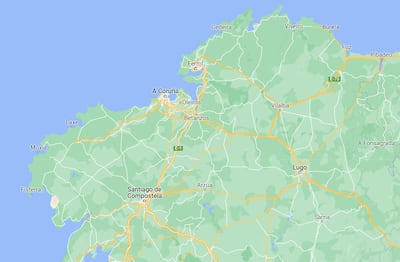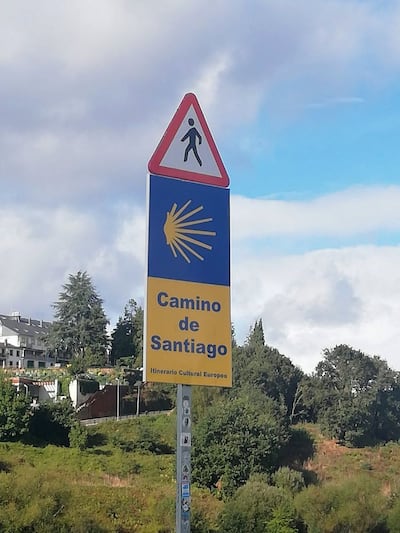For more than 1,000 years, peregrinos, as pilgrims are known in Spanish, have walked in the footsteps of the St James along the Camino de Santiago towards the apostle’s final resting place, in the Cathedral of Santiago de Compostela. Each year this pilgrimage attracts hundreds of thousands of people from across the world, travelling by foot, bike, boat or horseback along routes that all ultimately lead to this Spanish city in northwest Spain.
Recently, along with five others, I travelled the 113.7km route of the Camino Frances from Sarria to Santiago de Compostela over the course of five days.
I had hoped by the end of my journey to have determined why the Camino de Santiago, of Way of St James, draws so many people of all ages, faiths and backgrounds into undertaking what can be an arduous journey, whether in the heat of the summer or the mixed autumnal weather.
Before my departure, one outcome my fellow travellers had guaranteed I would reap from the trip would be tired, swollen, sore and blistered feet. With plenty of blister packs and plasters of every size, well-cushioned socks and my “well-walked into” shoes, I felt ready for anything foot-related to be thrown at me.
‘In Ireland the level of incompetence is really frustrating’
The forgotten Irish artist: How does an artist make thousands of artworks, then just disappear?
Congrats to Cillian Murphy but there’s no way of turning this into a good look
A Galway man in Dubai: ‘You would always be cautious not to step out of line but I’ve no regrets’
Yet the reaction I received from so many upon hearing of my forthcoming trip was so positive: “The Camino? It’s on my bucket list would love to do it sometime.” “I have been meaning to do it, if only I could get the time off work.” “The Camino? Best thing we ever did.”
These reactions excited me because I began to believe I was embarking on a trip that many wanted to experience and yet for those that had, they could not explain to me clearly what exactly it was that made the Camino so special.
It did not take long before I realised I was joining a unique community, symbolised by a shell hanging on the backpacks of fellow peregrinos. Perhaps some were, like me, on a personal mission, while I am sure there were others who felt they were on a mission impossible as they struggled to navigate another steep hill in the Spanish countryside in the pouring rain. However, the pain was shared and everybody kept going, encouraging each other along the way. Wandering through the vineyards of the Galician countryside, meeting others from all across the globe – New Zealand, Canada, Korea and Peru to name but a few – conversation was easy to strike up with the all too familiar “Buen Camino!” greeting.
Brother and sister John Claffey and Mary Conroy from Ireland were on the Camino for their second time having completed an earlier part of the Frances route in 2016. The highlight for John was yet again being able to experience the “absolute joy and pleasure of walking the Camino with additional family members and friends while meeting and chatting with other peregrinos along the way”. Most people were open to talk about the reasons that had led them to the farmlands, forest paths and cornfields in the middle of nowhere, while other walkers were closed off, lost in their thoughts.
Janet and Dawn, from Toronto in Canada, were six weeks into their trek. Loving every minute of it, they disclosed their secret to sustaining strength on the long walks. “Bananas and Coca-Cola,” they laughed. As they continued on their journey with socks pegged to their backpacks drying in the early morning sun, Dawn proudly shouted back: “I beat cancer, that’s why I’m doing it.”

It was clear some people had a clear, particular reason for doing the Camino, while others often did not even know themselves until they had reached the end of the trip, looked back and reflected on what they had taken from the journey.
As easy as it was to become lost and content in your own company on the walk, it was equally easy to turn and find a companion, such as Janet or Dawn, who were willing to incorporate you into their conversations before moving on.
[ Walking in a winter wonderland: Christmas walks around Ireland for all the familyOpens in new window ]
After walking the first 8km of the day, I met Michael, “a proud Irish-New Zealander”, on a much-needed coffee stop one morning. “Mícheál is ainm dom” and “dún an doras is what my late mother taught me” his opening line to me was upon hearing my Irish accent. Like many of the encounters I had on the Camino, formal introductions were never required and within two minutes of meeting Michael we were like two old friends as he reminisced about his recent trip to Ireland and his plans upon reaching Santiago de Compostela. It was clear that the fast pace at which Michael spoke mirrored the pace at which he wanted to visit and do everything he could in the time he had on this side of the world.

The days away made me reflect on the phrase “wellbeing”, which we hear increasingly often in the workplace and education sector. Personally, I felt walking the Camino would do more for people’s wellbeing than all related books on the market. With pressure from society or self-pressure to achieve certain things by definitive points in their lives, many feel judged on their career paths, whether they are a homeowner or not, have children or not, the number of extra-curricular activities their child is doing, how many play-dates their kids were invited on last weekend. The list is never-ending.
Over the course of the week away, not one person asked me a personal question. It was immaterial. It was going to make no difference to their lives what I did, where I lived or if I drove an electric car or not. My fellow peregrinos were more interested in my feet and if I had blisters yet. Of course, as an extended family of six travelling together, the next question was if “any of you had fallen out yet? Wait it will happen!” they would laugh.
Upon reaching the end of our road at the imposingly beautiful Cathedral de Santiago de Compostela, we gathered together and hugged. We had walked 113km in rain and sunshine, over some incredibly steep hills through cornfields, rustic villages and orchards. With no phones or text messages to interrupt us and a never-ending path, conversations were real: illness, losing family members and the impact these events had had. John had been accompanied on the trip by not only sister but his son David Claffey, who admitted “he wasn’t sure what to expect at the beginning of the week”. However, as the days drew to a close, David found he was unable to “say exactly what it has been that’s made the trip so meaningful... I think it was a combination of things that made it quite special to be honest”.

Inside the cathedral, time stood still. People sat in no rush to leave, gazing up at the magnificent altar; perhaps contemplating their journey to Santiago de Compostela, a journey that may have taken days or a lifetime.
As Mary took her place in one of the pews and looked back on the past few days, she felt “the Camino had brought calmness to busy lives and had for many provided the opportunity for reflection”. Indeed, the Camino had the power to knock down the physical and mental perimeters of our daily lives and show us that there is an incredibly large open world going on out there if we just stop and take the time to get out and explore it.
















